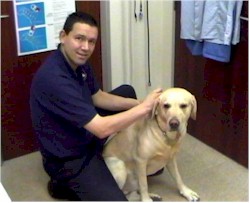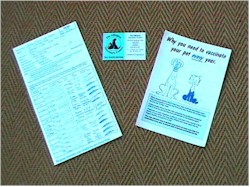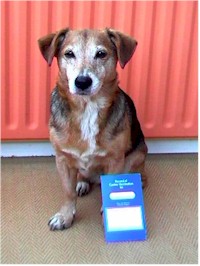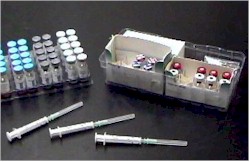|
Co-sponsors of the 2023 Winning Out
Certificates



| |
To boost
or not to boost...
 Recently
an interesting article appeared in The Veterinary Record, the vet’s professional
magazine, about the duration of immunity in dogs after vaccination or naturally acquired
infection. In other words, it discussed what is known about the protection against infectious
diseases after having been in contact with them, or vaccinated against them, and how often we
should be giving booster vaccinations. Vet Peter van Dongen summarises. Recently
an interesting article appeared in The Veterinary Record, the vet’s professional
magazine, about the duration of immunity in dogs after vaccination or naturally acquired
infection. In other words, it discussed what is known about the protection against infectious
diseases after having been in contact with them, or vaccinated against them, and how often we
should be giving booster vaccinations. Vet Peter van Dongen summarises.
Vaccination is an important component of a complete health
programme. Vets are generally recommended to follow the manufacturer’s directions in
administering vaccines, which often include once yearly re-vaccination. However, recently
questions have been raised about the duration of immunity and about whether adult dogs really
need yearly ‘boosters.’
History
Widespread vaccination became possible in the
1940s with the development of modified live vaccines for Distemper and Adenovirus (This virus
causes viral hepatitis.) Early work showed that the duration of protection against Distemper
was thought to be less than one year and it was suggested to recommend annual vaccination.
Since the 60s yearly vaccination of dogs has become established as a standard of practice and
this has reduced the incidence of disease considerably. For example, the incidence of Distemper
decreased from 10% between 1919 and 1964 to 0.1% between 1980 and 1991! However, some people
have called into question the safety of vaccines and reports of for instance auto-immune
diseases have resulted in widespread discussions about the appropriate use of vaccines.
 Measurement
of immunity Measurement
of immunity
The immune response of dogs to infection or
vaccination has often been evaluated by measuring titres of antibodies in the blood. However,
although these titres correlate with protection against Distemper, Parvo, Hepatitis and
Leptospira (Weil’s Disease), they do not necessarily correlate with protection against
Bordetella, Para-Influenza virus (the latter two are involved in ‘Kennel Cough’) and Corona
virus. Also, dogs respond to antigenic challenge (disease or vaccination) in various ways, only
one of which is the production of antibodies.
Duration of immunity after
vaccination
Unfortunately there is not a lot of information
about how long immunity lasts after vaccination. This is mainly because this information has
historically not been needed for the authorisation or licensing of vaccines. This has changed
with Rabies vaccines though: the vaccine has to be proven to give protection for at least one
year, to be licensed. For most other vaccines the duration of immunity has been estimated on
the basis of the persistence of antibodies in the blood, although this may not always be
adequate, as outlined above.
The following information is known about the major
components of modern vaccines:-
 Rabies Rabies
After natural infection with Rabies most dogs
will die and this makes it difficult to estimate the duration of immunity. The evidence of long
term immunity after vaccination is based on challenge and the measurement of antibody levels.
As part of the Pet Travel Scheme, dogs are required to have an antibody level of at least 0.5
IU/ml, but dogs with less than this have been known to survive challenge. Most dogs will be
protected for between one and three years.
Distemper
If dogs are infected with Distemper and survive,
they will normally have a long lived immunity. After vaccination, the level of immunity is
measured by determining antibody levels. Information about the protection in humans against
Measles after vaccination is also used, as Distemper and Measles are related. In some dogs
protection can last very long, but in high risk patients, such as certain young dogs and old
dogs, the determination of antibody titres can indicate whether re-vaccination is required. A
recent study suggested that yearly re-vaccination should be maintained.
Parvo
Protection against Parvo can last quite long
after natural infection, if the patient survives. The persistence of immunity against Parvo
after vaccination probably lasts at least one year, but long term studies have not been
conducted. It is probably shorter than in Distemper or Rabies.
Adenovirus
There are two types of this virus, one causes
viral hepatitis and the other respiratory disease. Immunity against one protects against the
other as well. Not enough is known about the duration of immunity after natural infection, but
after vaccination protection probably lasts at least one year.
L eptospira eptospira
Nobody knows how long immunity lasts after
natural infection! We do know that the bacteria can persist for a very long time in dogs which
have been exposed to the disease, even if they have high levels of antibodies. Immunity after
vaccination is thought to be short lived and long term studies have not been performed.
Bordetella & Para-Influenza
virus
After natural infection with either of these
causative agents of ‘Kennel Cough’, protection is thought to be short lived, probably in the
region of seven months. Long term protection after vaccination has not been evaluated properly
yet.
Duration of immunity standards
There are several scientific, technical and
economic reasons which have made it difficult to carry out studies which give good information
about the duration of immunity. These include the necessity to include unvaccinated control
animals, kept under specialised conditions, but also the fact that individual vaccines can
differ in their characteristics and formulations. Therefore, each and every vaccine would have
to be evaluated separately. In the absence of valid data, an annual re-vaccination ensures a
minimal level of protection under the most challenging circumstances!
Vaccines as an important
component of a complete pet health programme
 There
are two purposes of vaccination: firstly to protect individuals from disease, but also to
maintain a sufficiently large immune population so that disease is not readily transmitted. For
each individual disease there is a certain proportion of the population which has to be
protected to prevent outbreaks. If this proportion is lower than the threshold, because of
waning of vaccine immunity or lack of vaccination, outbreaks are more likely to occur. In
humans this has happened with measles, polio and diphtheria in the last few decades. In dogs
the threshold levels are not known for most diseases. However, where most dogs are vaccinated,
diseases such as Distemper, Parvo, Hepatitis and Rabies are rare. But outbreaks can occur if
the population immunity decreases, just like in humans. This occurred in Finland, where 5,000
dogs were affected by Distemper recently, after not having had the disease for 16 years! Just
like in human medicine, it is important to remember that to continue protection against canine
diseases it is imperative to maintain an adequate population immunity. Therefore more
veterinary research is necessary to develop appropriate vaccination protocols. There
are two purposes of vaccination: firstly to protect individuals from disease, but also to
maintain a sufficiently large immune population so that disease is not readily transmitted. For
each individual disease there is a certain proportion of the population which has to be
protected to prevent outbreaks. If this proportion is lower than the threshold, because of
waning of vaccine immunity or lack of vaccination, outbreaks are more likely to occur. In
humans this has happened with measles, polio and diphtheria in the last few decades. In dogs
the threshold levels are not known for most diseases. However, where most dogs are vaccinated,
diseases such as Distemper, Parvo, Hepatitis and Rabies are rare. But outbreaks can occur if
the population immunity decreases, just like in humans. This occurred in Finland, where 5,000
dogs were affected by Distemper recently, after not having had the disease for 16 years! Just
like in human medicine, it is important to remember that to continue protection against canine
diseases it is imperative to maintain an adequate population immunity. Therefore more
veterinary research is necessary to develop appropriate vaccination protocols.
Vaccination recommendations
Every dog is unique in its breeding, lifestyle,
life stage, geographical location and risk of exposure to disease. It is, therefore, difficult to make blanket recommendations on the use of vaccines. All the information
about a certain individual dog must be evaluated to tailor its vaccination to its specific
needs. The problem is that the persistence of immunity against all the diseases of concern is
not easily determined in each individual dog. Even blood tests are not always helpful,
particularly in cases where we know that immunity does not correlate to antibody levels.
Reference: Coyne, M. J. et al. (2001) Duration of immunity in dogs after
vaccination or naturally acquired infection.
The Veterinary Record 149, 509-515
 About
the author... About
the author...
Peter van Dongen
qualified as a vet at the Utrecht Veterinary school, The Netherlands,
in March 1990. He worked in a mixed practice in Louth, Lincolnshire for three years, before
moving to Borough Green, Kent. At the same time he limited himself to small animals only. Since
December 1996, he has run a branch practice in Allington, Maidstone, Kent.
In May
1995 Peter started agility (after years of just thinking about it!) with his Jack Russell Cross
'Basil' (a bitch!), then five years old. Since then they have qualified for many finals,
including Crufts and Olympia. Basil, Peter's first and still only agility dog, is now an
'Advanced' dog - the highest level in the UK - and still going strong at the age of 11 years!
Basil has won the coveted Crufts 2001 title in the individual Mini agility.
Peter passed the Agility Club Instructors' exam in October 1999 and has since done the
British Agility Club Judging Workshop.
Peter and
his wife Carry still live in Borough Green with their two dogs and two cats.
|
Vets & Pets is a bound collection of a series of
articles originally published monthly by The Agility Voice and The Agility Eye.
All profits from the sale of the book will go to a dog charity.
To read a review or buy the book,
click here. |
| |
|